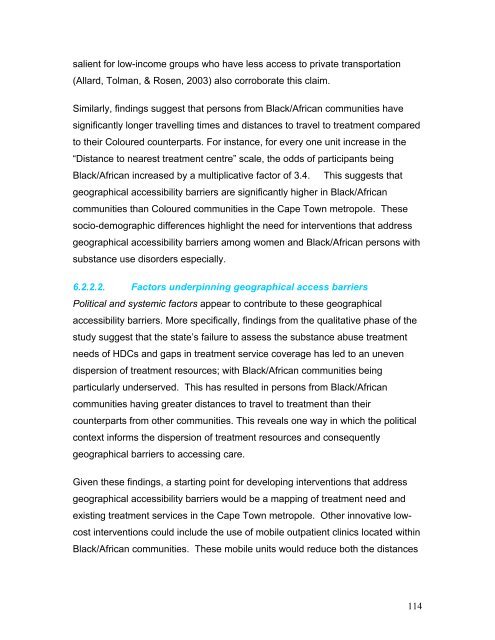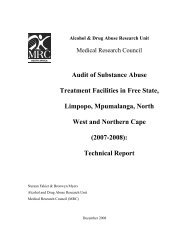Access to substance abuse treatment in the Cape Town metropole ...
Access to substance abuse treatment in the Cape Town metropole ...
Access to substance abuse treatment in the Cape Town metropole ...
You also want an ePaper? Increase the reach of your titles
YUMPU automatically turns print PDFs into web optimized ePapers that Google loves.
salient for low-<strong>in</strong>come groups who have less access <strong>to</strong> private transportation(Allard, Tolman, & Rosen, 2003) also corroborate this claim.Similarly, f<strong>in</strong>d<strong>in</strong>gs suggest that persons from Black/African communities havesignificantly longer travell<strong>in</strong>g times and distances <strong>to</strong> travel <strong>to</strong> <strong>treatment</strong> compared<strong>to</strong> <strong>the</strong>ir Coloured counterparts. For <strong>in</strong>stance, for every one unit <strong>in</strong>crease <strong>in</strong> <strong>the</strong>“Distance <strong>to</strong> nearest <strong>treatment</strong> centre” scale, <strong>the</strong> odds of participants be<strong>in</strong>gBlack/African <strong>in</strong>creased by a multiplicative fac<strong>to</strong>r of 3.4. This suggests thatgeographical accessibility barriers are significantly higher <strong>in</strong> Black/Africancommunities than Coloured communities <strong>in</strong> <strong>the</strong> <strong>Cape</strong> <strong>Town</strong> <strong>metropole</strong>. Thesesocio-demographic differences highlight <strong>the</strong> need for <strong>in</strong>terventions that addressgeographical accessibility barriers among women and Black/African persons with<strong>substance</strong> use disorders especially.6.2.2.2. Fac<strong>to</strong>rs underp<strong>in</strong>n<strong>in</strong>g geographical access barriersPolitical and systemic fac<strong>to</strong>rs appear <strong>to</strong> contribute <strong>to</strong> <strong>the</strong>se geographicalaccessibility barriers. More specifically, f<strong>in</strong>d<strong>in</strong>gs from <strong>the</strong> qualitative phase of <strong>the</strong>study suggest that <strong>the</strong> state’s failure <strong>to</strong> assess <strong>the</strong> <strong>substance</strong> <strong>abuse</strong> <strong>treatment</strong>needs of HDCs and gaps <strong>in</strong> <strong>treatment</strong> service coverage has led <strong>to</strong> an unevendispersion of <strong>treatment</strong> resources; with Black/African communities be<strong>in</strong>gparticularly underserved. This has resulted <strong>in</strong> persons from Black/Africancommunities hav<strong>in</strong>g greater distances <strong>to</strong> travel <strong>to</strong> <strong>treatment</strong> than <strong>the</strong>ircounterparts from o<strong>the</strong>r communities. This reveals one way <strong>in</strong> which <strong>the</strong> politicalcontext <strong>in</strong>forms <strong>the</strong> dispersion of <strong>treatment</strong> resources and consequentlygeographical barriers <strong>to</strong> access<strong>in</strong>g care.Given <strong>the</strong>se f<strong>in</strong>d<strong>in</strong>gs, a start<strong>in</strong>g po<strong>in</strong>t for develop<strong>in</strong>g <strong>in</strong>terventions that addressgeographical accessibility barriers would be a mapp<strong>in</strong>g of <strong>treatment</strong> need andexist<strong>in</strong>g <strong>treatment</strong> services <strong>in</strong> <strong>the</strong> <strong>Cape</strong> <strong>Town</strong> <strong>metropole</strong>. O<strong>the</strong>r <strong>in</strong>novative lowcost<strong>in</strong>terventions could <strong>in</strong>clude <strong>the</strong> use of mobile outpatient cl<strong>in</strong>ics located with<strong>in</strong>Black/African communities. These mobile units would reduce both <strong>the</strong> distances114
















